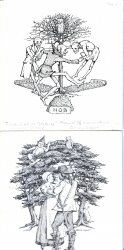
[Wilfrid Pippet, member of noted Solihull family of ecclesiastical artists and designers.] Eleven signed original illustrations for Thomas Wright of Olney’s ‘Buckinghamshire and Northamptonshire Ballads’ (including 'The Three Men of Yardley Chase').
The Pippets of Solihull were a Roman Catholic family that worked closely on ecclesiastical designs with the Gothic Revival firm Hardman & Co (whose archives are held by the Birmingham Museum and Art Gallery). Wilfrid also collaborated with J. B. Trinick on the striking illustrations to A. E. Waite’s rosicrucian ‘Album of the Great Symbols of the Paths’ (1917-21; copy in the British Museum Department of Prints and Drawings). Eleven attractive illustrations in black ink (over pencil draft). Each on a piece of board (‘Faced with Whatman Hand-made Paper’), and ranging in size from 16 x 19.5 cm to 15.5 x 13.5 cm. All in good condition, lightly aged and worn. Each is annotated in pencil, several with the line of poetry being illustrated, and some with instructions for transferring the illustration to a block. Several of the illustrations are to the ballad ‘The Three Men of Yardley Chase’, with one showing the three men (George, Ben and Hob) standing in front of a tree used on the front cover when the ballad was issued as a separate fascicule ('Part I', with ‘Leather and Thread and Tears’, 3rd ed, 1925). This illustration, and two others, are signed ‘Wilfrid Pippet’, while the other eight are signed ‘W. P.’ The most striking illustration (featuring on p.13 of the printed volume) is of the ghosts of the three men dancing over their graves around a tree with an owl in it. Two illustrations depict the doorway of the ‘WHITE HART HOTEL | HELEN SMITH’, one with three figures in Georgian dress in the foreground. Another shows the three men with ‘Hedge-hog meat’, and another (depicting a beggar with a raven on his shoulder is captioned with a line from the poem ‘Base people bred to mar their peace’. There are also: a drinking scene (including mother with baby), a dandy admiring himself in the mirror with a woman in a bonnet behind him, a man and woman in Tudor costume, three men (with a badger) listening to a beggar with a crow on his shoulder, and two lovers, in seventeenth-century garb, in front of two trees with owl, pixie and white rabbit. See Image.


